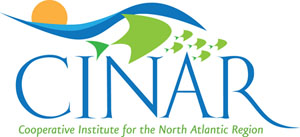Will One Gulf’s Tragedy Affect Drilling in Another?
The environmental catastrophe unfolding in the Gulf of Mexico has brought much attention to the role of offshore oil drilling in meeting society’s growing energy needs.
In March, the Obama administration announced it would open parts of the U.S. continental shelf for oil drilling. The moratorium on east coast drilling north of Delaware was extended until 2017, to the relief of fishermen, environmentalists and others concerned about the health of the Gulf of Maine ecosystem.
Cutline info: A researcher studies a porbeagle shark in the Bay of Fundy.
The horrific explosion on the Deepwater Horizon just three weeks later led to an announcement by the Obama administration that it has put a hold on any new licenses for offshore drilling. The disaster, in which 11 workers were lost and are presumed dead and safety features designed to prevent the escape of oil failed to work, has raised many questions about offshore drilling, a process with a history that includes death and injury to workers as well as environmental damage.
In fact, an offshore drilling accident in the Santa Barbara Channel off the coast of California in 1969 helped spawn the modern environmental movement. Soon after Union Oil’s offshore wells were bored in January of that year, one blew out, causing a massive oil slick that killed birds, fish and marine mammals and led to a moratorium on drilling off California. Until the Deepwater Horizon explosion, the grounding of the Exxon Valdez tanker was considered the worst U.S. oil catastrophe. That spill polluted 2,400 kilometers of Alaskan coast and spewed 42,000 tons of oil into Prince William Sound.
Experts said soon after the explosion that the Deepwater well was gushing the equivalent of the Exxon Valdez spill into the Gulf of Mexico every four days, but estimates of the volume have continued to rise steadily ever since.
More than a month after the accident, oil is still spewing from the broken well into the Gulf – with severe environmental and economic impacts; contamination threatens the valuable fisheries of the Gulf, the extensive wetland ecosystems of Louisiana and Mississippi, and the tourism industry from Texas to the Florida Keys.
The ensuing debate regarding the risks of drilling for oil and gas mirrors a similar controversy that played out in the Gulf of Maine in the 1980s when drilling on Georges Bank was first proposed. While several test wells were drilled on the Bank (no oil was discovered), public furor over the potential environmental risks resulted in establishment of a moratorium on drilling in the area. In 1988, the US and Canada jointly agreed to a moratorium on oil exploration on the Bank. It is set to expire in 2012. The Obama administration’s recent unilateral action extends the moratorium until 2017 and applies to that portion of the Bank in U.S. territorial waters.
The huge oil spill in the Gulf of Mexico also got the attention of the province of Nova Scotia which had been debating the possibility of opening the Canadian portion of the Bank, known as the Northeast Peak, to oil and gas exploration when the moratorium expires in 2012. The province currently supports gas production in the Sable Island area; a new gas facility, located west of the Sable Island field, is scheduled to come on line in a few months. The province has mapped potential oil and gas reserves throughout its waters. Rights to the Northeast Peak are already held by companies interested in potential oil exploration activities.
Dr. Steve Turnbull, an expert on sharks and whales who teaches at the University of New Brunswick, has this response to the prospect of oil drilling on Georges bank: “It’s a bad idea and could affect not only the species I work on, which are highly migratory in and out of the Bay of Fundy, but every single species. Given the high tides and massive amounts of water that flow into the Bay of Fundy each day, twice a day, a spill would be catastrophic. Some of the larger animals may avoid the spill by avoiding the area altogether, but they will miss the opportunity to feed in rich waters during the summer months which would likely lead, in turn, to a decrease in reproductive fitness. But a spill would also affect the entire food chain from microorganisms through baitfish all the way up to the whales. Fisheries would collapse and already endangered species would be put more at risk.”
On May 13, Nova Scotia and the Canadian federal government announced that the moratorium would be extended for three years, until December 31, 2015. Noting that lessons could be learned from the Gulf disaster, Energy Minister Bill Estabrooks said in a statement that “we value and respect our ocean ecosystem……..In order to make the right decision, we need more time to get the best scientific information available.” A review is underway to determine if changes in oil drilling technology and procedures since the moratorium was last extended in 1999 warrant a reconsideration of drilling on Georges Bank.
“We know that any decision on whether or not to lift the moratorium on Georges Bank could have significant economic and environmental impacts on the province, the country, and beyond,” Nova Scotia Premier Darrell Dexter said in the same statement. “It is critical that government understands these impacts before such a decision is made.”
While happy that the moratorium will be extended for three years, opponents of offshore drilling questioned why the extension of moratorium is not longer. Denny Morrow, Executive Director of the Nova Scotia Fish Packers Association and chair of the NoRigs3 Coalition, a group comprised of aboriginal groups, environmentalists, processors and fishermen, says he would have preferred “an indefinite moratorium, or, as a second choice, to stay in sync with the American moratorium.
“The two large blowouts of the last several months, in Australia and more recently Louisiana, expose some of the myths around this whole issue. One is that technology can overcome human error and the unexpected forces of nature. Another is that regulation can prevent these kinds of experiences. The US, Australia – and Canada – have good regulatory regimes for oil and gas but they have proven themselves to be inadequate.”
Morrow went on to point out that his group is not opposed to oil drilling in less risky and less biologically productive areas but noted that “this is not just about commercial fish and shellfish; Georges Bank is a feeding area for whales, birds and other sea life.”
Print



















